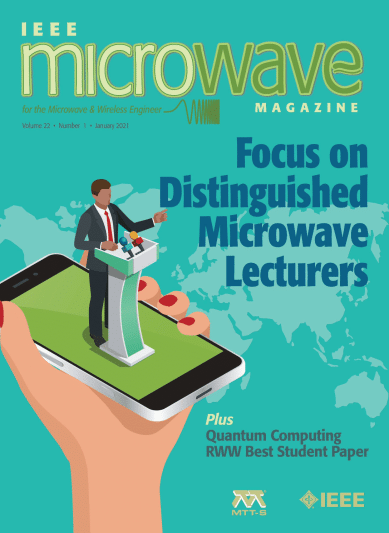About the journal
On behalf of the editorial board and staff at IEEE Microwave Magazine, we would like to wish you a happy, prosperous, and safe 2021.
This first issue of 2021 reflects a number of changes, with 2020 MTT-S President Al Albunjaileh transferring the President’s gavel to Gregory Lyons. This month’s “President’s Column” presents Lyons’ outline and vision for 2021 and is a must read to see the important items on the MTT-S agenda for the year. The MTT-S Administrative Committee welcomes new members, as mentioned in the “President’s Column”; their names have been added to the masthead on page 3. Our flagship IMS conference has a four-page preview section devoted to the exciting events being planned.
Closer to home, IEEE Microwave Magazine welcomes a new associate editor, Dr. Chia-Chang Chan, National Chung Cheng University, Taiwan. This month’s issue offers three technical features, including two articles by MTT-S Distinguished Microwave Lecturers (DMLs), and one student competition winner. The first feature, “Nonresonating Modes Do It Better!” by S. Bastioli and R.V. Snyder is based on Dr. Bastioli’s DML presentation and conveys the potential positive impact that so-called parasitic modes might have on a filter’s performance. The article describes important steps in filter design as well as the use of doublets in waveguide filter architectures. It also covers filter designs in coaxial lines, dielectrics, and cavity resonators. This wide-ranging feature contains something for anyone involved in filter design. The second DML feature, “Trends in Wireless Power Transfer” by N. Shinohara, looks at developments in wireless power transfer that originated more than 100 years ago through work by Nikola Tesla. The article covers energy harvesters and optimization techniques for increasing the performance of these circuits, an important technology that is finding increased use in powering wireless sensors for wireless charging. Our third technical feature is the final article in the quantum computing series initiated in our August 2020 focus issue and guest edited by Joseph Bardin. This work, “Cryogenic CMOS Circuits and Systems” by Charbon et al., provides a brief introduction to quantum processors and qubits and focuses on cryogenic CMOS solutions for these processors as well as the microwave excitation and readout configurations that can provide bandwidths into the multi-gigahertz range. The article presents exciting uses of microwaves at the quantum level and is right up our technological alley. The final feature article introduces the winner of the 2020 RWW Student Paper Competition, Aaron Day. The article, “Phase Perturbation as a Measurement Metric,” is a joint effort. This is the perfect issue for publishing a winning student paper, as you should receive it just prior to RWW 2021, which, for the current year, will be a virtual event.
In addition to technical features, we have the next installment of “Microwave Bytes,” by Steve Cripps, where the goings on in the gap between microwave and light spectra are presented. We also have many of our usual columns, such as “MicroBusiness,” “Microwave Surfing,” “Women in Microwaves,” “Around the Globe” (which this month is a reprint from the James Clerk Maxwell Foundation Newsletter on Maxwell’s thoughts on standards. In keeping with the issue’s theme, a report in our society news column covers the planning for and delivery of a virtual DML talk for the IIT Kharagpur Student Branch Chapter. In addition, our “Speaker’s Corner” column is by DLM Simone Bastioli and recounts his experiences serving in this position (as noted previously, a feature article based on his presentation also appears in this issue). If you have ever given thought to becoming a DML, this column provides an insider’s look at the rewards and challenges of this very important role in the MTT-S. Takashi Ohira continues his challenging “Enigmas, etc.” series with the start of a new topic area focusing on switching waveforms as part of the path to a deeper understanding of switching amplifiers. Of course, the solution to last month’s puzzle is also provided.
Finally, we have our “Conference Calendar” for the next seven months; as mentioned in previous columns, however, please check conference websites for any updates to locations, dates, and modalities (in person, hybrid, or fully virtual), as changes could occur after the magazine goes to press. I hope you enjoy the issue, and happy new year!
Robert Caverly
Current issue
